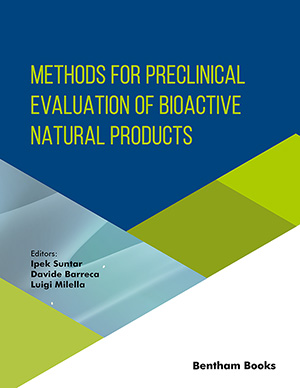Abstract
Acute liver injury (ALI) is a critical and fatal disorder associated with excessive Although considerable advances have been made in the early diagnosis and treatment of breast cancer, it is still one of the major causes of global cancer-related death in women over the last several decades. Phytochemicals have been shown to be promising agents in the prevention and treatment of breast cancer. Resveratrol is an important plant-derived polyphenolic compound with a variety of potent biological activities. It has been suggested that resveratrol can be used to prevent and treat various types of cancer, including breast cancer. Resveratrol can affect numerous signaling pathways in vitro, leading to the induction of cell cycle arrest and apoptosis, suppression of proliferation, reduction of inflammatory responses, and the inhibition of angiogenesis and metastasis. Nevertheless, studies of resveratrol in animal models of breast cancer have so far been disappointing.
Keywords: Breast cancer, resveratrol, cancer therapy, phytochemicals, signaling pathways, chemotherapy.
[http://dx.doi.org/10.1515/hmbci-2020-0021] [PMID: 33079703]
[http://dx.doi.org/10.1016/j.lfs.2021.120047] [PMID: 34653429]
[http://dx.doi.org/10.3389/fonc.2013.00313] [PMID: 24400218]
[http://dx.doi.org/10.1039/D1FO01611C] [PMID: 34647945]
[http://dx.doi.org/10.1016/j.intimp.2020.106905] [PMID: 32905970]
[PMID: 2040005]
[http://dx.doi.org/10.1023/A:1005921513083] [PMID: 9596481]
[http://dx.doi.org/10.1200/JCO.2007.12.7878] [PMID: 17827455]
[http://dx.doi.org/10.1158/1541-7786.MCR-08-0548] [PMID: 19671685]
[http://dx.doi.org/10.2174/138945010791170842] [PMID: 20298150]
[http://dx.doi.org/10.1186/1477-7827-9-91] [PMID: 21693041]
[http://dx.doi.org/10.2741/3730] [PMID: 21196213]
[http://dx.doi.org/10.1002/mnfr.201100619] [PMID: 22125182]
[http://dx.doi.org/10.2174/138945012804545632] [PMID: 23140290]
[http://dx.doi.org/10.1021/jf204084f] [PMID: 22300613]
[http://dx.doi.org/10.2174/138945012804545551] [PMID: 23140282]
[http://dx.doi.org/10.2174/187152012803833008] [PMID: 22583403]
[http://dx.doi.org/10.1097/CEJ.0b013e328364f23e] [PMID: 23939462]
[http://dx.doi.org/10.1007/s11101-014-9337-5] [PMID: 25395898]
[http://dx.doi.org/10.2174/1568009615666141229152256] [PMID: 25544650]
[http://dx.doi.org/10.1002/biof.1206] [PMID: 25857627]
[http://dx.doi.org/10.4048/jbc.2013.16.1.72] [PMID: 23593085]
[http://dx.doi.org/10.1016/j.maturitas.2013.07.006] [PMID: 23916376]
[http://dx.doi.org/10.3945/ajcn.112.034165] [PMID: 22760559]
[http://dx.doi.org/10.1007/s10549-009-0415-0] [PMID: 19437116]
[http://dx.doi.org/10.2174/0929867326666191212101225] [PMID: 31830881]
[http://dx.doi.org/10.2741/e399] [PMID: 22201894]
[http://dx.doi.org/10.3389/fphar.2012.00141] [PMID: 22822401]
[http://dx.doi.org/10.1111/nyas.12145] [PMID: 23855466]
[http://dx.doi.org/10.1016/j.bbadis.2014.10.006] [PMID: 25315300]
[http://dx.doi.org/10.1007/978-3-642-38007-5_10] [PMID: 24114480]
[PMID: 15517885]
[http://dx.doi.org/10.1080/13880200802116610]
[http://dx.doi.org/10.1158/1940-6207.CAPR-08-0160] [PMID: 19401532]
[http://dx.doi.org/10.1016/j.ctrv.2009.10.002] [PMID: 19910122]
[http://dx.doi.org/10.1530/ERC-13-0171] [PMID: 24500760]
[http://dx.doi.org/10.1016/j.canlet.2009.01.041] [PMID: 19261378]
[http://dx.doi.org/10.1016/S0014-5793(97)01572-X] [PMID: 9468322]
[http://dx.doi.org/10.1016/j.mrrev.2007.08.004] [PMID: 17890139]
[http://dx.doi.org/10.1016/j.ejphar.2010.02.054] [PMID: 20303945]
[http://dx.doi.org/10.1016/0048-4059(76)90077-1]
[http://dx.doi.org/10.1016/S0009-9120(96)00155-5] [PMID: 9127691]
[http://dx.doi.org/10.1021/jf9900478] [PMID: 10552833]
[http://dx.doi.org/10.1021/jf0009910] [PMID: 11312782]
[http://dx.doi.org/10.1023/A:1005830714852] [PMID: 9225853]
[http://dx.doi.org/10.1023/B:JOEC.0000006444.79951.75]
[http://dx.doi.org/10.1016/j.canlet.2008.03.057] [PMID: 18550275]
[http://dx.doi.org/10.1016/j.foodchem.2006.01.047]
[PMID: 8998912]
[http://dx.doi.org/10.1021/jf9504576]
[http://dx.doi.org/10.1016/j.chroma.2005.05.083] [PMID: 16106702]
[http://dx.doi.org/10.1016/j.bbrc.2003.08.105] [PMID: 13679076]
[http://dx.doi.org/10.2174/187152807781696464] [PMID: 17897053]
[http://dx.doi.org/10.1097/WOX.0b013e3182439613] [PMID: 23268465]
[PMID: 20514401]
[http://dx.doi.org/10.1016/j.febslet.2005.12.059] [PMID: 16412432]
[http://dx.doi.org/10.1042/BST0351156] [PMID: 17956300]
[http://dx.doi.org/10.18632/oncotarget.7763] [PMID: 26934322]
[http://dx.doi.org/10.1097/00001813-199902000-00007] [PMID: 10211549]
[http://dx.doi.org/10.1126/science.278.5340.1073] [PMID: 9353183]
[http://dx.doi.org/10.1042/BSR20100136] [PMID: 21981137]
[http://dx.doi.org/10.1042/BJ20141337] [PMID: 25940732]
[http://dx.doi.org/10.1016/j.tips.2009.03.004] [PMID: 19446347]
[http://dx.doi.org/10.1002/mnfr.201500884] [PMID: 26833775]
[http://dx.doi.org/10.2217/pme.14.19] [PMID: 25506379]
[http://dx.doi.org/10.1158/1078-0432.CCR-15-1762] [PMID: 26673799]
[http://dx.doi.org/10.1016/j.canlet.2012.02.037] [PMID: 22406826]
[http://dx.doi.org/10.1016/j.semcancer.2016.03.005] [PMID: 27038646]
[http://dx.doi.org/10.1016/j.phrs.2017.11.023] [PMID: 29162539]
[http://dx.doi.org/10.1016/j.bcp.2012.07.015] [PMID: 22842489]
[http://dx.doi.org/10.2174/1570161115666170713094319] [PMID: 28707601]
[http://dx.doi.org/10.1200/JCO.2000.18.5.1135] [PMID: 10694567]
[http://dx.doi.org/10.1111/j.1582-4934.2006.tb00415.x] [PMID: 16796815]
[http://dx.doi.org/10.1016/j.biopha.2007.09.006] [PMID: 17988825]
[http://dx.doi.org/10.1021/jf904182y] [PMID: 20131808]
[http://dx.doi.org/10.1021/jf202426k] [PMID: 21942447]
[http://dx.doi.org/10.1021/jf104917q] [PMID: 21395220]
[http://dx.doi.org/10.1111/j.1349-7006.2009.01415.x] [PMID: 20028382]
[http://dx.doi.org/10.1016/j.canlet.2011.04.009] [PMID: 21794976]
[http://dx.doi.org/10.2147/CMAR.S4544] [PMID: 21188121]
[http://dx.doi.org/10.1158/0008-5472.CAN-10-2027] [PMID: 20841478]
[http://dx.doi.org/10.1016/j.jnutbio.2012.04.005] [PMID: 22889612]
[http://dx.doi.org/10.1002/ijc.20884] [PMID: 15688382]
[http://dx.doi.org/10.1207/S15327914nc391_14] [PMID: 11588890]
[http://dx.doi.org/10.2147/IJN.S204443] [PMID: 31417252]
[PMID: 19956893]
[http://dx.doi.org/10.1093/carcin/bgr226] [PMID: 22016468]
[http://dx.doi.org/10.7314/APJCP.2013.14.3.1703] [PMID: 23679260]
[http://dx.doi.org/10.3892/ijo.2020.5107] [PMID: 32945383]
[http://dx.doi.org/10.3892/or.2020.7747] [PMID: 32901891]
[http://dx.doi.org/10.1016/j.fitote.2013.02.005] [PMID: 23428654]
[http://dx.doi.org/10.1038/sj.onc.1207666] [PMID: 15122319]
[http://dx.doi.org/10.1096/fj.04-3582fje] [PMID: 15837718]
[http://dx.doi.org/10.1371/journal.pone.0015627] [PMID: 21209944]
[http://dx.doi.org/10.1093/carcin/bgm144] [PMID: 17675339]
[PMID: 18439064]
[http://dx.doi.org/10.1016/j.jsbmb.2019.105406] [PMID: 31185279]
[http://dx.doi.org/10.3748/wjg.v9.i7.1474] [PMID: 12854144]
[http://dx.doi.org/10.1186/1479-5876-7-22] [PMID: 19321006]
[http://dx.doi.org/10.1111/bjh.12154] [PMID: 23205612]
[http://dx.doi.org/10.1002/cncr.29793] [PMID: 26619367]
[http://dx.doi.org/10.1016/j.taap.2014.01.011] [PMID: 24467951]
[http://dx.doi.org/10.1038/oncsis.2015.49] [PMID: 26807644]
[http://dx.doi.org/10.1016/j.bbalip.2015.05.001] [PMID: 25964209]
[http://dx.doi.org/10.1016/j.bbadis.2014.10.005] [PMID: 25315298]
[http://dx.doi.org/10.1038/nm730] [PMID: 12091876]
[http://dx.doi.org/10.1016/j.cell.2011.02.013] [PMID: 21376230]
[http://dx.doi.org/10.4049/jimmunol.169.10.5538] [PMID: 12421930]
[http://dx.doi.org/10.1002/cncr.24899] [PMID: 20143437]
[http://dx.doi.org/10.1182/blood-2006-10-051482] [PMID: 17363736]
[http://dx.doi.org/10.1158/2159-8290.CD-13-0310] [PMID: 24078774]
[http://dx.doi.org/10.1158/0008-5472.CAN-12-2384] [PMID: 23288508]
[http://dx.doi.org/10.1016/j.coi.2014.01.004] [PMID: 24531241]
[http://dx.doi.org/10.1038/srep13110] [PMID: 26279307]
[http://dx.doi.org/10.1186/s12964-015-0093-y] [PMID: 25889536]
[http://dx.doi.org/10.1093/annonc/mdw217] [PMID: 27207108]
[http://dx.doi.org/10.1056/NEJMoa1200690] [PMID: 22658127]
[http://dx.doi.org/10.1200/JCO.2013.53.0105] [PMID: 24590637]
[http://dx.doi.org/10.1056/NEJMoa1305133] [PMID: 23724846]
[http://dx.doi.org/10.1002/cncr.25747] [PMID: 21523733]
[http://dx.doi.org/10.1056/NEJMoa1507643] [PMID: 26412456]
[http://dx.doi.org/10.1056/NEJMoa1504627] [PMID: 26028407]
[http://dx.doi.org/10.1016/S0140-6736(15)01281-7] [PMID: 26712084]
[http://dx.doi.org/10.1056/NEJMoa1510665] [PMID: 26406148]
[http://dx.doi.org/10.1038/nri3405] [PMID: 23470321]
[http://dx.doi.org/10.1172/JCI83871] [PMID: 26325031]
[http://dx.doi.org/10.1172/JCI80011] [PMID: 26325035]
[http://dx.doi.org/10.1126/scitranslmed.aad7118] [PMID: 26936508]
[http://dx.doi.org/10.1056/NEJMoa1411087] [PMID: 25482239]
[http://dx.doi.org/10.3892/ijo.2018.4512] [PMID: 30066852]
[http://dx.doi.org/10.1016/j.cell.2008.03.027] [PMID: 18485877]
[http://dx.doi.org/10.1016/j.pharmthera.2017.08.009] [PMID: 28834698]
[http://dx.doi.org/10.1016/j.biocel.2007.07.011] [PMID: 17825600]
[http://dx.doi.org/10.1016/j.canlet.2010.03.020] [PMID: 20413216]
[http://dx.doi.org/10.2174/18715206113139990078] [PMID: 23272910]
[http://dx.doi.org/10.1038/nprot.2009.152] [PMID: 19834475]
[http://dx.doi.org/10.3390/jcm5040041] [PMID: 27043642]
[http://dx.doi.org/10.1016/j.bbrc.2016.06.077] [PMID: 27320862]
[PMID: 27347327]
[http://dx.doi.org/10.3390/molecules24061131]
[http://dx.doi.org/10.1038/cddis.2016.6] [PMID: 26890143]
[http://dx.doi.org/10.3747/co.v16i2.428] [PMID: 19370178]
[http://dx.doi.org/10.1111/j.1440-1681.2011.05660.x] [PMID: 22211760]
[http://dx.doi.org/10.1371/journal.pone.0103760] [PMID: 25072848]
[PMID: 17201156]
[http://dx.doi.org/10.2174/092986710794182980] [PMID: 21062260]
[http://dx.doi.org/10.1016/j.devcel.2008.07.008] [PMID: 18694566]
[http://dx.doi.org/10.1158/0008-5472.CAN-13-1841] [PMID: 24204025]
[http://dx.doi.org/10.1016/j.devcel.2008.07.002] [PMID: 18694565]
[http://dx.doi.org/10.18632/oncotarget.2192] [PMID: 25026296]
[http://dx.doi.org/10.1111/j.1440-1746.2008.05666.x] [PMID: 19175831]
[http://dx.doi.org/10.1039/c1mb05181d] [PMID: 21766137]
[http://dx.doi.org/10.1016/j.humpath.2010.12.010] [PMID: 21458843]
[http://dx.doi.org/10.1002/mnfr.201100141] [PMID: 21714127]
[http://dx.doi.org/10.1006/bbrc.2002.6554] [PMID: 11866465]
[http://dx.doi.org/10.1593/tlo.07100] [PMID: 18607509]
[http://dx.doi.org/10.1155/2020/5393041] [PMID: 32149115]
[http://dx.doi.org/10.18632/oncotarget.25631] [PMID: 30018739]
[http://dx.doi.org/10.18632/aging.101175] [PMID: 28238967]
[http://dx.doi.org/10.3390/ijms19082204]
[http://dx.doi.org/10.3390/toxins11120731] [PMID: 31847250]
[http://dx.doi.org/10.3390/cancers11121947] [PMID: 31817453]
[http://dx.doi.org/10.1093/carcin/bgq143] [PMID: 20622002]
[http://dx.doi.org/10.3892/ijo.2020.5017] [PMID: 32236622]
[http://dx.doi.org/10.1155/2020/5432651] [PMID: 33204396]
[http://dx.doi.org/10.1038/s41523-020-00178-5] [PMID: 32864429]
[http://dx.doi.org/10.3390/ijms21155244] [PMID: 32721999]
[http://dx.doi.org/10.1016/j.ajps.2018.03.002] [PMID: 32104440]
[http://dx.doi.org/10.3390/cancers11111739] [PMID: 31698751]
[http://dx.doi.org/10.1038/s41598-019-50416-5] [PMID: 31562347]
[http://dx.doi.org/10.1371/journal.pone.0219317] [PMID: 31310624]
[http://dx.doi.org/10.3390/ijms20133275] [PMID: 31277289]
[http://dx.doi.org/10.1016/j.tox.2019.04.009] [PMID: 31004704]
[PMID: 32436827]
[http://dx.doi.org/10.1039/C9TB02051A] [PMID: 31746932]
[http://dx.doi.org/10.1016/j.pharep.2019.08.005] [PMID: 31561186]
[http://dx.doi.org/10.1016/j.bbrc.2019.09.016] [PMID: 31519327]
[http://dx.doi.org/10.1002/mnfr.201900629] [PMID: 31441212]
[http://dx.doi.org/10.1002/biof.1544] [PMID: 31317586]
[http://dx.doi.org/10.1016/j.biocel.2019.05.020] [PMID: 31173924]
[http://dx.doi.org/10.1002/jcb.28910] [PMID: 31155753]
[http://dx.doi.org/10.1002/jcb.28836] [PMID: 31069826]
[http://dx.doi.org/10.3892/or.2019.7122] [PMID: 31002359]
[http://dx.doi.org/10.1021/acs.jafc.8b06444] [PMID: 30789269]





























